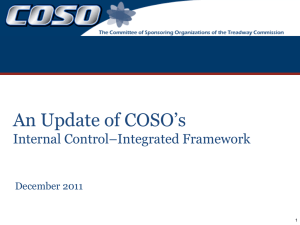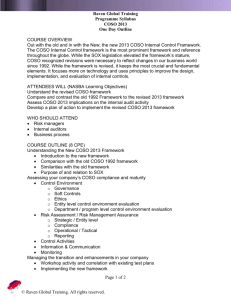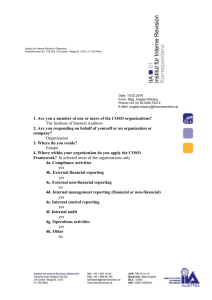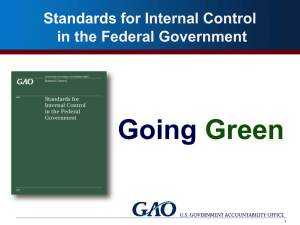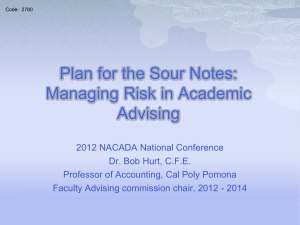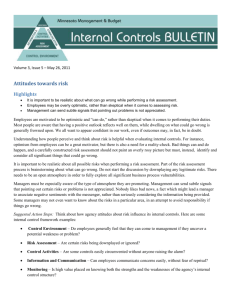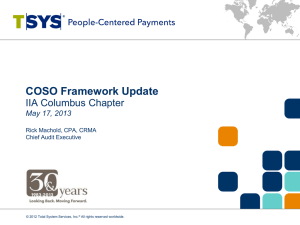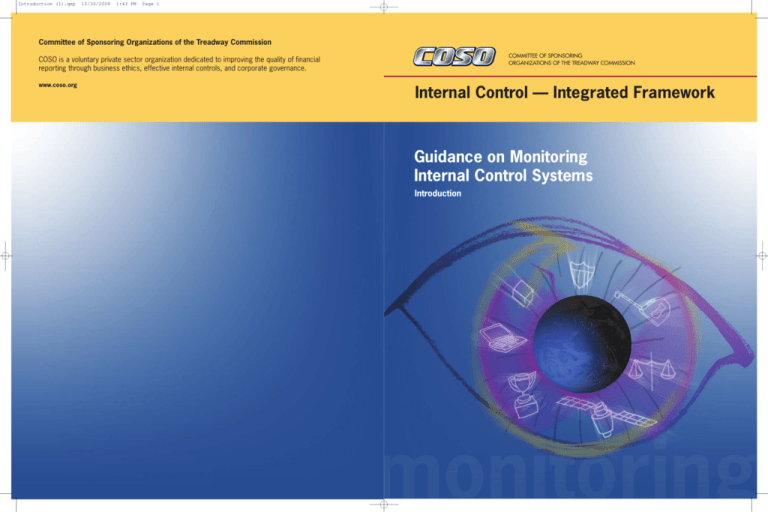
Introduction (1).qxp
12/30/2008
1:43 PM
Page 1
Committee of Sponsoring Organizations of the Treadway Commission
COMMITTEE OF SPONSORING
ORGANIZATIONS OF THE TREADWAY COMMISSION
COSO is a voluntary private sector organization dedicated to improving the quality of financial
reporting through business ethics, effective internal controls, and corporate governance.
www.coso.org
Internal Control — Integrated Framework
Guidance on Monitoring
Internal Control Systems
Introduction
Committee of Sponsoring Organizations
of the Treadway Commission
Board Members
Larry E. Rittenberg
Mark S. Beasley
Michael P. Cangemi
COSO Chair
American Accounting Association
Financial Executives International
Charles E. Landes
David A. Richards
Jeffrey Thomson
American Institute of Certified Public
Accountants
The Institute of Internal Auditors
Institute of Management Accountants
Grant Thornton LLP Author
Principal Contributors
R. Trent Gazzaway (Project Leader)
James P. Burton
J. Russell Gates
Keith O. Newton
Managing Partner of Corporate Governance
Grant Thornton LLP Charlotte
Partner
Grant Thornton LLP Denver
President
Dupage Consulting LLC Chicago
Partner
Grant Thornton LLP Chicago
Sridhar Ramamoorti
Richard L. Wood
R. Jay Brietz
Partner
Grant Thornton LLP Chicago
Partner
Grant Thornton LLP Toronto
Senior Manager
Grant Thornton LLP Charlotte
Andrew D. Bailey Jr.
Dorsey L. Baskin Jr.
Craig A. Emrick
Philip B. Livingston
Senior Policy Advisor
Grant Thornton LLP Phoenix
Regional Partner of
Professional Standards
Grant Thornton LLP Dallas
VP Senior Accounting Analyst
Moody’s Investors Service
Vice Chairman, Approva Corporation
Former President and CEO,
Financial Executives International
Review Team
COSO Task Force
Abraham D. Akresh
Douglas J. Anderson
Robert J. Benoit
Richard D. Brounstein
Senior Level Expert for Auditing Standards
U.S. Government Accountability Office
Corporate Auditor
Dow Chemical Company
President and Director of
SOX Research
Lord & Benoit, LLC
Chief Financial Officer,
NewCardio, Inc.
Director, The CFO Network
Jennifer M. Burns
Paul Caban
James W. DeLoach
Miles E. Everson
Partner
Deloitte & Touche LLP
Assistant Director
U.S. Government Accountability
Office
Managing Director
Protiviti
Partner
PricewaterhouseCoopers LLP
Audrey A. Gramling
Scott L. Mitchell
James E. Newton
Edith G. Orenstein
Associate Professor
Kennesaw State University
Chairman and CEO
Open Compliance & Ethics Group
Partner
KPMG LLP
Director, Technical Policy Analysis
Financial Executives International
John H. Rife
Michael P. Rose
Robert S. Roussey
Andre Van Hoek
Partner
Ernst & Young LLP
Partner
Grant Thornton LLP
Former CEO and Senior Partner
GR Consulting LLP
Professor of Accounting
University of Southern California
Vice President, Corporate Controller
Celgene Corporation
Observer
Securities and Exchange Commission
Josh K. Jones
SEC Observer
Professional Accounting Fellow
Copyright © 2009, The Committee of Sponsoring Organizations of the Treadway Commission (COSO)
Guidance on Monitoring
Internal Control Systems
Introduction
January 2009
Copyright © 2009, The Committee of Sponsoring Organizations of the Treadway Commission (COSO)
Copyright © 2009, The Committee of Sponsoring Organizations of the Treadway Commission (COSO).
1 2 3 4 5 6 7 8 9 0 LCN 0870517953
All Rights Reserved. No part of this publication may be reproduced, redistributed, transmitted or displayed in any form or by any means
without written permission. For information regarding licensing and reprint permissions please contact the American Institute of Certified
Public Accountants, licensing and permissions agent for COSO copyrighted materials. Direct all inquiries to copyright@aicpa.org or to AICPA,
Attn: Manager, Rights and Permissions, 220 Leigh Farm Rd., Durham, NC 27707. Telephone inquiries may be directed to 888-777-7707.
Additional copies of this work may be obtained by visiting www.cpa2biz.com.
1
Monitoring: An Integral Component of Internal Control Over the past decade, organizations have invested heavily in improving the quality of
their internal control systems. They have made the investment for a number of
reasons, notably: (1) good internal control is good business — it helps organizations
ensure that operating, financial and compliance objectives are met, and (2) many
organizations are required to report on the quality of internal control over financial
reporting, compelling them to develop specific support for their certifications
and assertions.
Internal control is designed to assist organizations in achieving their objectives. The
five components of COSO’s Internal Control — Integrated Framework (the COSO
Framework) work in tandem to mitigate the risks of an organization’s failure to
achieve those objectives.
The COSO Board recognizes that management’s assessment of internal control often
has been a time-consuming task that involves a significant amount of annual
management and/or internal audit testing. Effective monitoring can help streamline
the assessment process, but many organizations do not fully understand this
important component of internal control. As a result, they underutilize it in
supporting their assessments of internal control.
Figure 1 depicts the comprehensive nature of monitoring and illustrates how effective
monitoring considers the collective effectiveness of all five components of
internal control.
Monitoring Applied to the Internal Control Process
Figure 1
COSO’s 2008 Guidance on Monitoring Internal Control Systems (COSO’s
Monitoring Guidance) was developed to clarify the monitoring component of
internal control. It does not replace the guidance first issued in the COSO
Framework or in COSO’s 2006 Internal Control over Financial Reporting —
Guidance for Smaller Public Companies (COSO’s 2006 Guidance). Rather, it
Copyright © 2009, The Committee of Sponsoring Organizations of the Treadway Commission (COSO)
2
expounds on the basic principles contained in both documents, guiding organizations
in implementing effective and efficient monitoring.
How Does Monitoring Benefit the Governance Process? Unmonitored controls tend to deteriorate over time. Monitoring, as defined in the
COSO Framework, is implemented to help ensure “that internal control continues to
operate effectively.” 1 When monitoring is designed and implemented appropriately,
organizations benefit because they are more likely to:
•
Identify and correct internal control problems on a timely basis,
•
Produce more accurate and reliable information for use in decision-making,
•
Prepare accurate and timely financial statements, and
•
Be in a position to provide periodic certifications or assertions on the
effectiveness of internal control.
Over time effective monitoring can lead to organizational efficiencies and reduced
costs associated with public reporting on internal control because problems are
identified and addressed in a proactive, rather than reactive, manner.
Fundamentals of Effective Monitoring
COSO’s Monitoring Guidance builds on two fundamental principles originally
established in COSO’s 2006 Guidance:2
•
Ongoing and/or separate evaluations enable management to determine
whether the other components of internal control continue to function over
time, and
•
Internal control deficiencies are identified and communicated in a timely
manner to those parties responsible for taking corrective action and to
management and the board as appropriate.
The monitoring guidance further suggests that these principles are best achieved
through monitoring that is based on three broad elements:
•
Establishing a foundation for monitoring, including (a) a proper tone at
the top; (b) an effective organizational structure that assigns monitoring roles
to people with appropriate capabilities, objectivity and authority; and (c) a
starting point or “baseline” of known effective internal control from which
ongoing monitoring and separate evaluations can be implemented;
1
COSO Framework, p. 69.
2
See principles #19 and #20 in COSO’s Internal Control over Financial Reporting – Guidance for
Smaller Public Companies issued in 2006 (COSO’s 2006 Guidance).
Copyright © 2009, The Committee of Sponsoring Organizations of the Treadway Commission (COSO)
3
•
Designing and executing monitoring procedures focused on persuasive
information about the operation of key controls that address meaningful risks
to organizational objectives; and
•
Assessing and reporting results, which includes evaluating the severity of
any identified deficiencies and reporting the monitoring results to the
appropriate personnel and the board for timely action and follow-up if
needed.
Breadth of Monitoring Processes
Organizations may select from a wide variety of monitoring procedures, including
but not limited to:
•
Periodic evaluation and testing of controls by internal audit,
•
Continuous monitoring programs built into information systems,
•
Analysis of, and appropriate follow-up on, operating reports or metrics that
might identify anomalies indicative of a control failure,
•
Supervisory reviews of controls, such as reconciliation reviews as a normal
part of processing,
•
Self-assessments by boards and management regarding the tone they set in
the organization and the effectiveness of their oversight functions,
•
Audit committee inquiries of internal and external auditors, and
•
Quality assurance reviews of the internal audit department.
Continued advancements in technology and management techniques ensure that
internal control and related monitoring processes will change over time. However,
the fundamental concepts of monitoring, as outlined in COSO’s Monitoring
Guidance, are designed to stand the test of time.
Using the Guidance to Move Monitoring Forward
Management can begin the monitoring process by encouraging the people with
control system responsibility to read COSO’s Monitoring Guidance and consider
how best to implement it or whether it has already been incorporated into certain
areas. Further, personnel with appropriate skills, authority and resources should be
charged by management with addressing these four fundamental questions:
1. Have we identified the meaningful risks to our objectives, for example, the
risks related to producing accurate, timely and complete financial statements?
2. Which controls are “key controls” that will best support a conclusion
regarding the effectiveness of internal control in those risk areas?
3. What information will be persuasive in telling us whether the controls are
continuing to operate effectively?
Copyright © 2009, The Committee of Sponsoring Organizations of the Treadway Commission (COSO)
4
4. Are we presently performing effective monitoring that is not well utilized in
the evaluation of internal control, resulting in unnecessary and costly further
testing?
Management and the board of directors should understand the concepts of effective
monitoring and how it serves their respective interests. As the board learns more
about monitoring, it will develop the knowledge necessary to ask management in
relation to any area of meaningful risk, “How do you know the internal control
system is working?”
COSO’s Monitoring Guidance is designed to help organizations answer these and
other questions within the context of their own unique circumstances —
circumstances that will change over time. As they progress in achieving effectiveness
in monitoring, organizations likely will have the opportunity to further improve the
process through the use of such tools as continuous monitoring software and
exception reports tailored to their processes.
The guidance also covers other concepts that are important to effective and efficient
monitoring, including:
•
The characteristics associated with the objectivity of the evaluator;
•
The period of time and the circumstances by which an organization can rely
on adequately designed indirect information — when used in combination
with ongoing or periodic persuasive direct information — to conclude that
internal control remains effective;
•
Determining the sufficiency and suitability of information used in
monitoring to ensure that the results can adequately support conclusions
about internal control; and
•
Ways in which the organization can make monitoring more efficient without
reducing its effectiveness.
COSO’s Monitoring Guidance encompasses three volumes. Volume I presents the
fundamental principles of effective monitoring and develops the linkage to the
COSO Framework. Volume II conveys in greater detail the principles outlined in
Volume I and provides guidance to those responsible for implementing effective
monitoring. Volume III contains examples of effective monitoring.
Many organizations, through applying the concepts set forth in the guidance, should
improve the effectiveness and efficiency of their internal control systems. To that
end, COSO’s Monitoring Guidance is designed to help organizations (1) identify
effective monitoring where it already exists and use it to the maximum benefit, and
(2) identify less effective or efficient monitoring, leading to improvements. In both
instances, the internal control system may be improved, increasing the likelihood that
organizational objectives will be achieved.
Copyright © 2009, The Committee of Sponsoring Organizations of the Treadway Commission (COSO)
Introduction (1).qxp
12/30/2008
1:43 PM
Page 1
Committee of Sponsoring Organizations of the Treadway Commission
COMMITTEE OF SPONSORING
ORGANIZATIONS OF THE TREADWAY COMMISSION
COSO is a voluntary private sector organization dedicated to improving the quality of financial
reporting through business ethics, effective internal controls, and corporate governance.
www.coso.org
Internal Control — Integrated Framework
Guidance on Monitoring
Internal Control Systems
Introduction


